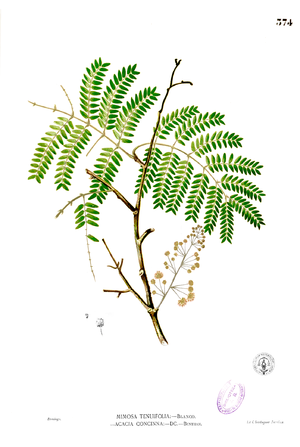Note: This is a project under development. The articles on this wiki are just being initiated and broadly incomplete. You can Help creating new pages.
Acacia concinna - Bahuphenarasa
Bahuphenarasa is a climbing shrub native to Asia, common in the warm plains of central and south India. It is commonly called as shikakai, Acacia hooperiana, Mimosa concinna etc. It's fruit is know as shikakai in India and ಸಿಗೆಕಾಯಿ in kannada. It is one of the good herbal remedy for hair.
Contents
Uses
Black fever, Malaria, diabetes, skin diseases.
Parts Used
Chemical Composition
In commercial extracts, when the plant is hydrolyzed it yields lupeol, spinasterol, acacic acid, lactone, and the natural sugars glucose, arabinose and rhamnose. It also contains hexacosanol, spinasterone, oxalic acid, tartaric acid, citric acid, succinic acid, ascorbic acid, and the alkaloids calyctomine and nicotine.[1]
Common names
| Language | Common name |
|---|---|
| Kannada | Sheegae, Shige kayi, Sigeballi |
| Hindi | Kochi, Reetha |
| Malayalam | Cheeyakayi, Chinik-kaya, Shikai, Cheenikka |
| Tamil | Shika, Sheekay, Chikaikkai |
| Telugu | Cheekaya, Chikaya, Gogu |
| Marathi | NA |
| Gujarathi | NA |
| Punjabi | NA |
| Kashmiri | NA |
| Sanskrit | Aaavartaki |
| English | Shikakai, Soap-pod |
Habit
Identification
Leaf
| Kind | Shape | Feature |
|---|---|---|
| alternate | stipulate | The leaves are alternate, stipulate, paripinnate compound, very numerous, closely placed, rachis 8.8-12.5 cm long, narrowly furrowed, slender, pubescent, with an erect linear gland between the leaflets of each pair, leaflets 16-24, very shortly stalked 2-2.5 cm long 1-1.3 cm broad, slightly overlapping, oval oblong, obtuse, at both the ends |
.[2]
Flower
| Type | Size | Color and composition | Stamen | More information |
|---|---|---|---|---|
| bisexual | 2.5 cm long | bright yellow | 5-20 | The racemes are few-flowered, short, erect, crowded in axils of upper leaves so as to form a large terminal inflorescence stamens barren; the ovary is superior, unilocular, with marginal ovules. |
Fruit
| Type | Size | Mass | Appearance | Seeds | More information |
|---|---|---|---|---|---|
| short legume | 7.5–11 cm long, 1.5 cm broad | clearly grooved lengthwise, Lowest hooked hairs aligned towards crown | oblong, obtuse, tipped with long style base, flat, thin, papery, undulately crimpled, pilose, pale brown. | 12-20 seeds | {{{6}}} |
Other features
List of Ayurvedic medicine in which the herb is used
- Vishatinduka Taila as root juice extract
Where to get the saplings
Mode of Propagation
How to plant/cultivate
Plants reach about 3 m height with 3.5 cm stem diameter in 2 years, in 4 years about 5 m height and 7 cm stem diameter. Flowering and fruiting is almost throughout the year, but in India there are usually two main flowering periods, one in the early monsoon and another in the late monsoon.[3]
Commonly seen growing in areas
Photo Gallery
References
External Links
- Pages that are stubs
- Ayurvedic Herbs known to be helpful to treat Black fever
- Ayurvedic Herbs known to be helpful to treat Malaria
- Ayurvedic Herbs known to be helpful to treat diabetes
- Ayurvedic Herbs known to be helpful to treat skin diseases.
- Herbs with fruits used in medicine
- Herbs with Bark used in medicine
- Herbs with Leaves used in medicine
- Herbs with common name in Kannada
- Herbs with common name in Hindi
- Herbs with common name in Malayalam
- Herbs with common name in Tamil
- Herbs with common name in Telugu
- Herbs with common name in Sanskrit
- Herbs with common name in English
- Habit - climbing shrub
- Index of Plants which can be propagated by Seeds
- Index of Plants which can be propagated by Cuttings
- Herbs that are commonly seen in the region of trophical region
- Herbs





